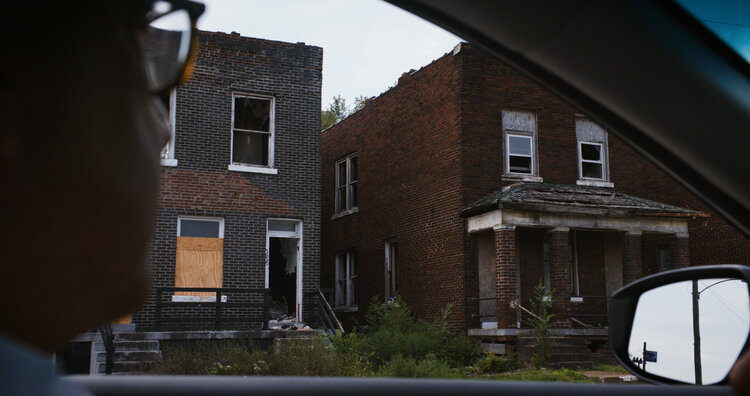Two films underscore the peril posed by a world of illusion made possible by our media, and the ideological mirages that such illusions can create.
Shelby Steele and America's “Poetic Truth”
“We human beings never use race except as a means to power. Race is never an end. It is always a means. It has no role in human affairs except as a corruption.”
Those are some of the first words spoken by noted cultural critic Shelby Steele in his brave and penetrating new documentary, What Killed Michael Brown? Written by Steele and directed by his son Eli, What Killed Michael Brown? is such a mature, sensible, empathetic, and penetrating work that it has already been banned by one major outlet. As the Wall Street Journal reported, Amazon shamefully blocked viewing of the film out of concern for their “content quality expectations” before relenting and making it available. Shelby Steele is a senior fellow at Stanford University’s Hoover Institution. He received a National Humanities Medal and won a National Book Critics Circle Award for his essay collection The Content of Our Character. He also produced an Emmy-Award winning documentary “Seven Days in Bensonhurst,” about Yusef Hawkins, a black teenager who was murdered by a racially motivated group of white attackers in 1989. Eli is a talented and accomplished filmmaker. Amazon’s “quality expectations” must be lofty, indeed.
The subject of the film is the death of Michael Brown, which became a political flash point in 2014. On August 9, 2014, police officer Darren Wilson shot and killed Michael Brown, an unarmed black teenager, in Ferguson, Missouri, a suburb of St. Louis. Fueled by the idea that racism had killed Michael Brown, protests and riots that began in Ferguson soon spread across the country. Attorney General Eric Holder, acting not only as a government official but “as a black man,” soon got the Department of Justice involved. The media assumed that it was a racially motivated crime and produced hysterical, often-inaccurate reporting.
From the four schools Brown attended in four years to the bad role models in the neighborhood, from the devastating social policies of the 1960s to the counterproductive anger of the black power movement and the media’s argument that racism is the same now as in 1950, what killed Michael Brown, the film concludes, was liberalism. Viewers may disagree with that, or think Steele is too conservative, but this is a work of bracing honesty, produced with integrity by one of the most level-headed voices in American political life. Amazon’s censorship was disgraceful. It is astonishing how charges that liberalism would become censorious and Orwellian—charges which once seemed a bit hyperbolic—have in fact become reality.
In the opening of What Killed Michael Brown?, Steele offers his bona fides as a former liberal activist—indeed, he was a “black militant” in the 1960s. The son of politically active parents in Chicago who protested to desegregate schools, Steele was a “warrior on President Johnson’s War on Poverty” as a young man. He recalls working in East St. Louis in the 1960s, convinced that his work, done in a “mood of wild hopefulness,” would change the country. “America had essentially confessed the evil of its racist past. The government that had pressed us only yesterday would now engineer our uplift.” His hope was short-lived as he witnessed corruption among his fellow activists and brutal black-on-black violence in the communities he wanted to serve. After three years, he was disillusioned: “Black development was not the focus of justice,” he recalls. “Taking advantage of white guilt was the focus.”
This is what Steele found when he traveled to Ferguson to investigate the situation in the aftermath of Michael Brown’s death. In the film, he interviews activists both on the left (Al Sharpton) and right (Robert Woodson), politicians, pastors, NAACP leaders, Ferguson locals, ex-gang leaders, and journalists. The direction by son Eli is graceful and understated, with a subtle jazz score kept low in the mix to let the voices be heard. The film intercuts archival footage with the modern interviews.
According to Steele, liberalism’s “dependency track” has been devastating to the black community.
The Ferguson protests, Steele said, seemed unconvincing—“the anger seemed ritualized, almost choreographed.” Wondering “why is it so hard to see the truth here,” Steele recreates the scene of the crime, standing right at the spot where Brown died. He concludes what the Justice Department ultimately did: that there was no reason to charge Officer Wilson with the unjustified shooting of Brown. According to witnesses, Brown charged at Wilson, who fired in self-defense. Still, there was “already a framework of meaning in place” before any evidence or witness testimony. If you were black, “all you could see was American racism.”
Steele calls the distortion of what actually happened between Wilson and Brown a “poetic truth.” A poetic truth is “a distortion of the actual truth that we use to sue for leverage for power in the world. It is a partisan version of reality, a storyline that we put forward to build our case.” The Michael Brown case, observes Steele, became “a competition between the poetic truth and the objective truth,” with the poetic truth acting like a “tyranny.” Poetic truth “overlays the present with imagery of past racial persecution,” conflating modern events like the Michael Brown shooting, which had nothing to do with race, with past atrocities that were based on race, like the murder of Emmitt Till and the whips of Bull Connor.
Thus tolerant, diverse, and majority-black Ferguson becomes South Africa in 1950. James Knowles, the Mayor of Ferguson, puts it this way: “The media couldn’t wait to say, look at this 65 percent African-American town with a white Republican mayor, 85 percent Democrat. They made me feel like this was South Africa. Like this was apartheid.” Several of the white residents of Ferguson point out that the people like them, who stayed after the “white flight” of the 1960s and have black friends and neighbors, didn’t stay in the town because they are racists. That the media didn’t do their job here is not surprising, though. They don’t do their job anywhere anymore.
When the Department of Justice concluded that Officer Wilson had done nothing wrong, it led one liberal journalist, Jonathan Capehart of the Washington Post, to admit that they had been wrong. For his honesty, Capehart was called an Uncle Tom and a sellout. “I did it because it was the right thing to do,” he says. From Al Sharpton to Eric Holder and the media, it was necessary to maintain the “poetic truth” that race played a part in Michael Brown’s death. “The danger of poetic truth is that it always traps us into solving the wrong problem,” Steele says. The problem wasn’t white racism, although that is still an issue, but “the enormously seductive power of 1960s liberalism,” a liberalism that was “far more focused on assuaging white guilt than on developing blacks.” Starting in the 1960s, “America’s racial guilt was our power. White guilt became black power.” To keep this power, blacks always had to be victims. This robbed them of “a sense of agency” in their own fate.
Along with this were some disastrous social policies, from the “urban renewal” that demolished black neighborhoods to welfare programs that paid if there was no man in the house. According to Steele, this “dependency track” has been devastating to the black community. “Liberalism’s great sin was to steal responsibility for black problems away from black people, leaving them vulnerable to destructive social forces,” he concludes. As Steele said in a recent interview, “there’s this rush that’s almost a desperate frenzy to see the event as an example of black victimization, to establish it as black victimization, and that, in a sense, becomes the argument.”
What Killed Michael Brown? is a gripping and thought-provoking film that will hopefully create honest debate around the issue of race. It’s the kind of documentary our media once had the guts to produce.


